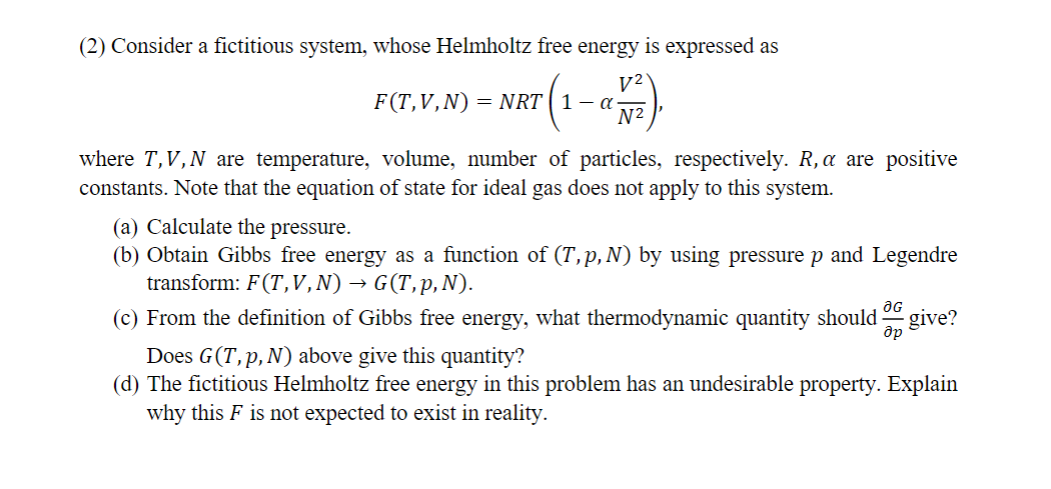(2) Consider a fictitious system, whose Helmholtz free energy is expressed as F(T,V,N) NRT 1 - α- -(1-ax). where T,V,N are temperature, volume, number of particles, respectively. R, a are positive constants. Note that the equation of state for ideal gas does not apply to this system. (a) Calculate the pressure. (b) Obtain Gibbs free energy as a function of (T,p,N) by using pressure p and Legendre transform: F(T,V,N) → G(T,p,N). OG др (c) From the definition of Gibbs free energy, what thermodynamic quantity should give? Does G(T,p,N) above give this quantity? (d) The fictitious Helmholtz free energy in this problem has an undesirable property. Explain why this F is not expected to exist in reality.
(2) Consider a fictitious system, whose Helmholtz free energy is expressed as F(T,V,N) NRT 1 - α- -(1-ax). where T,V,N are temperature, volume, number of particles, respectively. R, a are positive constants. Note that the equation of state for ideal gas does not apply to this system. (a) Calculate the pressure. (b) Obtain Gibbs free energy as a function of (T,p,N) by using pressure p and Legendre transform: F(T,V,N) → G(T,p,N). OG др (c) From the definition of Gibbs free energy, what thermodynamic quantity should give? Does G(T,p,N) above give this quantity? (d) The fictitious Helmholtz free energy in this problem has an undesirable property. Explain why this F is not expected to exist in reality.
Chapter2: The Kinetic Theory Of Gases
Section: Chapter Questions
Problem 2.4CYU: Check Your Understanding If you consider a very small object, such as a grain of pollen, in a gas,...
Related questions
Question

Transcribed Image Text:(2) Consider a fictitious system, whose Helmholtz free energy is expressed as
F(T,V,N) NRT 1 - α-
-(1-ax).
where T,V,N are temperature, volume, number of particles, respectively. R, a are positive
constants. Note that the equation of state for ideal gas does not apply to this system.
(a) Calculate the pressure.
(b) Obtain Gibbs free energy as a function of (T,p,N) by using pressure p and Legendre
transform: F(T,V,N) → G(T,p,N).
OG
др
(c) From the definition of Gibbs free energy, what thermodynamic quantity should give?
Does G(T,p,N) above give this quantity?
(d) The fictitious Helmholtz free energy in this problem has an undesirable property. Explain
why this F is not expected to exist in reality.
Expert Solution
This question has been solved!
Explore an expertly crafted, step-by-step solution for a thorough understanding of key concepts.
Step by step
Solved in 2 steps with 1 images

Recommended textbooks for you


Classical Dynamics of Particles and Systems
Physics
ISBN:
9780534408961
Author:
Stephen T. Thornton, Jerry B. Marion
Publisher:
Cengage Learning

Modern Physics
Physics
ISBN:
9781111794378
Author:
Raymond A. Serway, Clement J. Moses, Curt A. Moyer
Publisher:
Cengage Learning


Classical Dynamics of Particles and Systems
Physics
ISBN:
9780534408961
Author:
Stephen T. Thornton, Jerry B. Marion
Publisher:
Cengage Learning

Modern Physics
Physics
ISBN:
9781111794378
Author:
Raymond A. Serway, Clement J. Moses, Curt A. Moyer
Publisher:
Cengage Learning